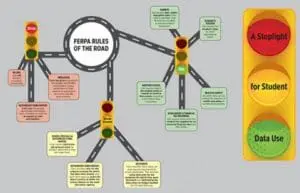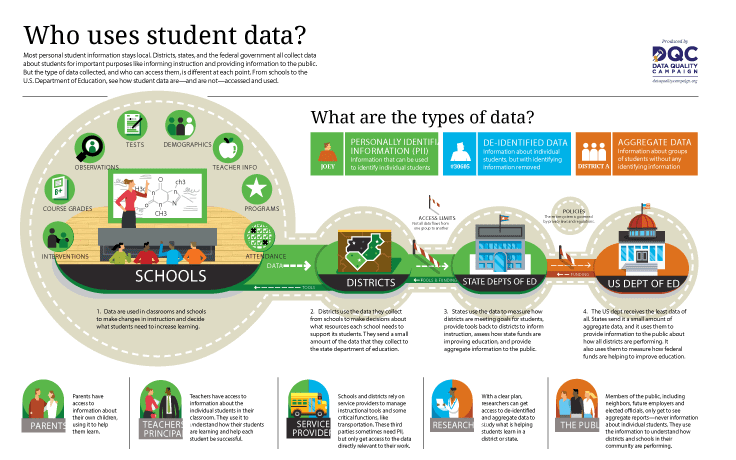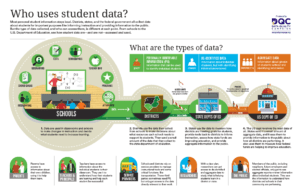Any vision for data use is incomplete without a plan to protect student privacy. Data is a powerful tool to guide decisionmaking, and its security must be prioritized. Clear privacy policies enable parents and school leaders to confidently use data to support students. A lack of clear policies leaves decisionmakers in the dark and puts students at risk. The following resources show how everyone with a stake in education can take steps to ensure that data can effectively and securely play a role in helping students succeed.
Prioritizing Data Privacy Policy from Local Schools to the Federal Government
Parent Guide on Education Data is a one-pager, co-authored by the National PTA, that reminds parents of their right to clear information about how schools serve their children. Additionally, this guide provides questions parents can ask school leaders about how data is used to support student learning.
Who Uses Student Data? shows how schools, districts, states, and the federal government all collect different data for different purposes to inform instruction and provide information to the public. Our infographic and video show how data is used at each of these levels, and for what purpose.
Roadmap to Safeguarding Student Data is a set of detailed recommendations, drafted with the help of leading experts, that states should follow to ensure that they can effectively implement privacy policies. By focusing on transparency, governance, and data protection procedures, states can effectively prioritize data privacy and put themselves in a position to proactively address changes in technology.
Student Data Principles: The Data Quality Campaign is proud to co-sponsor, along with forty leading organizations in education policy, ten foundational principles for using and safeguarding students’ personal information. These principles represent a commitment to safely and ethically use data to support student success.
Roadmap for Cross-Agency Data Governance provides recommendations for states who are looking to develop and implement a high-quality cross-agency data governance committee. States are responsible for setting rules and assigning roles and responsibilities for how data is used and protected. This resource provides a roadmap for getting there, as well as examples of states with exemplary governance structures.
State Data Privacy Legislation Through the Years
For seven years, DQC has tracked state legislative efforts to govern the use of data in education. Privacy has been, and remains, an important part of these efforts. The following resources represent the years where privacy was the biggest focus of legislation around the country and show the evolution of legislative approaches to privacy. Earlier legislation represents a reaction to federal policy and emerging concerns around data safety, while more recent sessions show that policymakers understand that privacy and data effectiveness go hand in hand. For a full list of DQC state legislative reviews, please see our topic guide: State Legislators Have a Role in Making Data Use Possible.
State Student Data Privacy Legislation: What Happened in 2014, and What Is Next?: To address emerging concerns, new demands for student data, and increasing use of technology in classrooms, states introduced and passed an unprecedented number of bills to address student privacy. This resource provides a summary of 2014 state student data privacy legislation.
Student Data Privacy Legislation: What Happened in 2015, and What Is Next?: The student data privacy bills introduced in 2015 reflect both continued and newly developing student data privacy conversations in states and at the federal level. This resource summarizes the legislative activity around student data privacy in 2015.
Student Data Privacy Legislation: A Summary of 2016 State Legislation: Student data privacy was a priority issue in state legislatures in 2016, though as expected, states passed fewer student data privacy bills into law than they did in 2014 and 2015. The privacy conversation evolved, however, giving states the ability to borrow from each other: California’s 2014 Student Online Personal Information Protection Act (SOPIPA), the first to attempt to legislate the permissible activities of school service providers in the digital age, served as a model for many states in 2016. Most of the states that passed new laws in 2016 had already passed a student data privacy law, a sign that states are building on their efforts.
Education Data Legislation Review: 2017 State Activity: In the 2017 legislative session, data privacy continued to be a focus with more than half (93 of 183) of the state bills that were considered on education data addressing the issue. But 2017 also saw states increasingly using legislation to address how they collect, use, and report education data in addition to how they safeguard it.
Federal Rules of the Road
Safeguarding Data: Federal Privacy Laws that Apply to Children and Education identifies and describes foundational federal policies that govern education records, health information, and online safety for children.
A Stoplight for Student Data Use takes a deeper dive into the Family Educational Rights and Privacy Act (FERPA), the federal law that establishes student privacy rights by restricting with whom and under what circumstances schools may share students’ personally identifiable information. This tool shows how FERPA governs access to data for different stakeholders.

As part of our webinar series on the Every Student Succeeds Act, Privacy and Effective Data Use Go Hand in Hand takes a deep dive into how the federal law provides opportunities for states to improve their ability to use data and ensure its safety.
The Federal Role in Safeguarding Student Data describes the current landscape of federal education privacy policy and also provides recommendations for federal action, such as working across federal agencies as well as coordinating with state governments, to provide practitioners with the clarity they need to safely and effectively use data.



